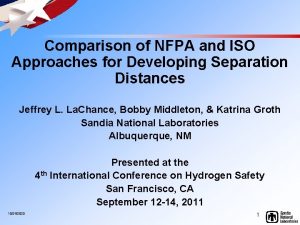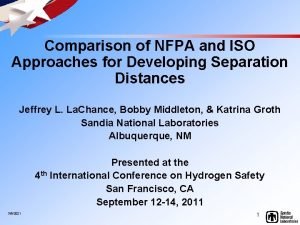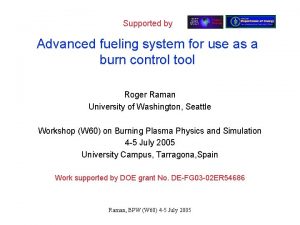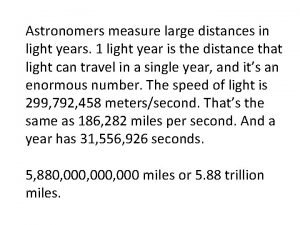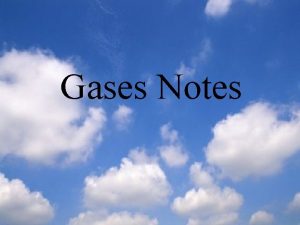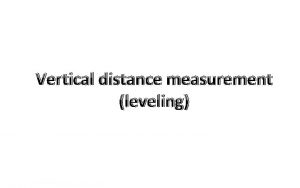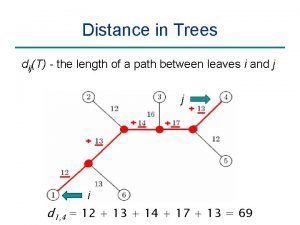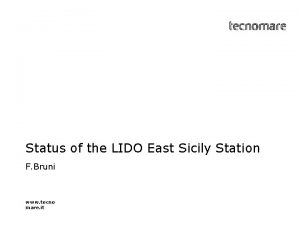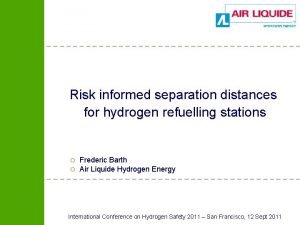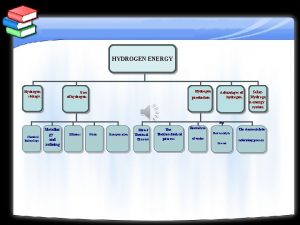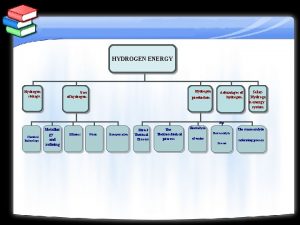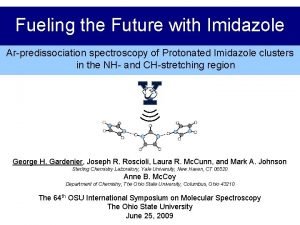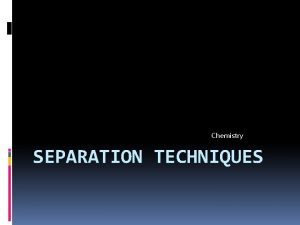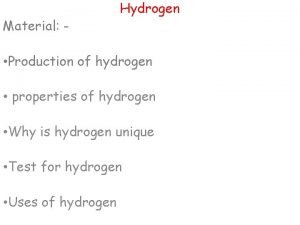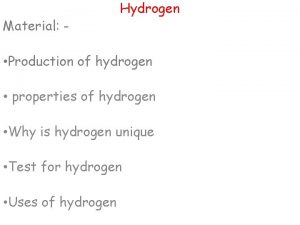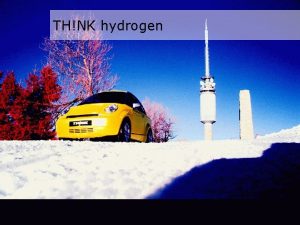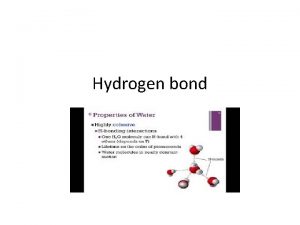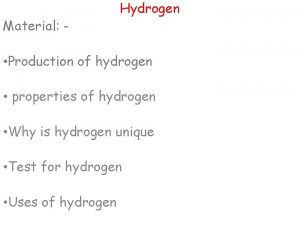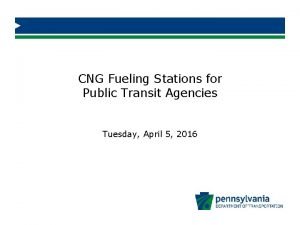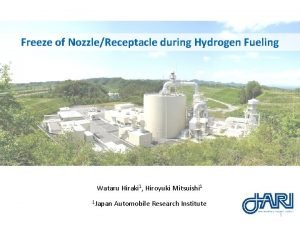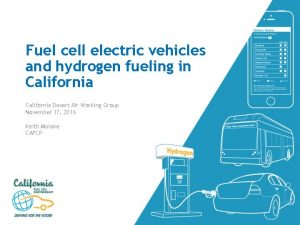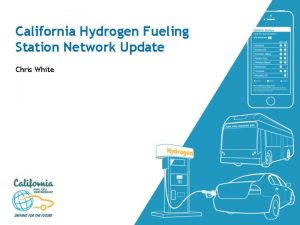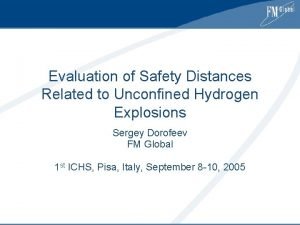RiskInformed Separation Distances for Hydrogen Fueling Stations Jeffrey





























- Slides: 29

Risk-Informed Separation Distances for Hydrogen Fueling Stations Jeffrey La. Chance Sandia National Laboratories 10/21/2021 Preliminary Data

Outline • • 10/21/2021 Project Background Separation Distances Risk-Informed Approach Description Application to an Example Facility Input Data and Assumptions for QRA Models Preliminary Results Conclusions Future Work Preliminary Data

Project Background • Work performed under U. S. DOE Hydrogen, Fuel Cells & Infrastructure Technologies Program, Multi-Year Research, Development and Demonstration Plan – Hydrogen Safety, Codes & Standard R&D • Sandia National Laboratories is developing the scientific basis for assessing credible safety scenarios and providing the technical data for use in the development of codes and standards – Includes experimentation and modeling to understand behavior of hydrogen for different release scenarios – Use of Quantitative Risk Assessment (QRA) methods to help establish separation (setback, safety) distances at hydrogen facilities and to identify accident prevention and mitigation strategies for key risk drivers 10/21/2021 Preliminary Data

Separation Distances • Specified distances in codes separating H 2 components from the public, structures, flammable material, and ignition sources • Distance vary with possible consequences from hydrogen releases (e. g. , radiation heat fluxes or overpressures) • Distances influenced by facility design parameters (e. g. , hydrogen pressure and volume), available safety features (e. g. , isolation valves), and release parameters (e. g. , leak size and location) Separation distances based solely on the consequences of hydrogen leaks can be large! 10/21/2021 Preliminary Data

Example of Consequence-Based Separation Distances for a Jet Fire Leak Diameter (mm) 10/21/2021 Preliminary Data

Separation Distances for Different Consequence Measures Consequence Measure 10/21/2021 Preliminary Data

Risk-Informed Approach • Uses risk insights plus other considerations to help define code requirements Risk = Frequency X Consequence from all accidents • Requires hydrogen component leak frequencies • Requires definition of important consequences • Uses QRA and consequence models to evaluate risk • Requires definition of acceptable risk levels • Accounts for parameter and modeling uncertainty present in analysis 10/21/2021 Preliminary Data

Risk Approach for Establishing Separation Distances Cumulative frequency Cumulative of accidentsfrequency requiring of accidents requiring this separation distance 10/21/2021 Preliminary Data

Use of Risk Eliminates Large Leaks from Consideration Pipe Leak Frequency Increasing Leak Diameter 10/21/2021 Preliminary Data

Application to Example Facility • Currently evaluating risk-informed separation distances for a representative fueling facility – To demonstrate risk methodology – To evaluate important facility features (e. g. , gas volume and leak isolation features) – To determine importance of modeling parameters (e. g. , data, geometry, temporal effects) – To identify key risk scenarios and identify possible ways to reduce the risk to acceptable levels • Work presented is focused on hydrogen jet releases from gas pipes and gas storage cylinders 10/21/2021 Preliminary Data

Example Facility Description • Facility can refuel 100 cars/day • All components located outside • Liquid hydrogen facility with no-onsite production – Liquid storage volume of 3000 kg @ 0. 55 Mpa – Cryo pump (11 L/min) used to provide pressurized liquid to vaporizer when pressure in gas storage decreases • Natural draft vaporizer • Gas storage was sized for 500 kg of hydrogen(12. 63 m 3 for 10000 psig facility) – Three separate cascades • Two refueling dispensers • Facility meets codes and standards 10/21/2021 Preliminary Data

Leakage Frequency Distributions 10/21/2021 Preliminary Data

Consequence Parameters and Risk Criteria Used in Current Analysis Consequence Parameters – Radiant Heat Flux from Jet Fires: • 1. 6 k. W/m 2 – no harm to individuals for long exposures • 4. 7 k. W/m 2 – injury (second degree burns) within 20 seconds • 25 k. W/m 2 – 100% lethality within 1 minute; equipment and structural damage – Hydrogen Concentration from Un-ignited Releases: • 4%, 6%, and 8% concentrations – lower flammability limit • Risk Criteria – Frequency of Fatality to Individual at Separation Distance Used as Upper Bound Accident Frequency Criteria • <2 E-4/yr – fatality risk from all other high-risk hazards in society 10/21/2021 Preliminary Data

Gas Pipe Analysis Assumptions • Leakage can occur in 50 m of 13. 5 mm diameter pipe, 4 valves, 2 instrument lines (4. 23 mm D), and 3 flanges • Hydrogen leak or flame detector sends signal to isolation valve resulting in closure within 10 s • Immediate ignition results in fatality at separation distance if not automatically detected and isolated (no credit for manual detection and isolation) • Delayed ignition of un-isolated gas jet results in flash fire – Fatality assumed out to distance corresponding to LFL (used to determine separation distance) • Pipe leak orientation was assumed directed at lot line resulting in maximum separation distances 10/21/2021 Preliminary Data

Gas Pipe Leak Event Tree Pipe Leak or Rupture Downstream of PIPE_LEAK 10/21/2021 pipe leak - (New Event Tree) Immediate Ignition Detection of Automatic Isolation Delayed Ignition of of Hydrogen Jet Hydrogen or Flame of Pipe within 10 s Hydrogen I-IGNITION DETECTION ISOLATION Preliminary Data D-IGNITION # END-STATE-NAMES 1 JET-FIRE-(10 -S) 2 JET-FIRE 3 JET-FIRE 4 GAS-RELEASE-(10 -S) 5 FLASH-FIRE 6 GAS-RELEASE 7 FLASH-FIRE 8 GAS-RELEASE 2007/01/27 Page 0

Gas Pipe Results: Un-isolated Jet Fires Mean frequency of any size un-isolated pipe leak < 1 E-6/yr 10/21/2021 Preliminary Data

Gas Pipe Results: Isolated Jet fire Exposure time to isolated jet fires is short which reduces potential for structural or equipment damage and personnel injury. 10/21/2021 Preliminary Data

Frequency of Fatality from Isolated Jet Fire (10 s exposure) 10 s exposure to 25 kw/m 2 heat flux results in 20% probability of a fatality (reducing the exposure time to 5 s would further reduce the probability to 5%). Operating Pressure 10/21/2021 Preliminary Data

Gas Pipe Results: Flash Fires Delayed ignition assumed to result in flash fire and fatality out to LFL. Hydrogen Concentration 10/21/2021 Preliminary Data

Gas Storage Analysis Assumptions • For each storage cylinder, leakage can occur in 1 m of 4. 23 mm diameter pipe and 1 valve attached to the cylinder, and from the cylinder itself. Leakage can also occur in manifold and 4 attached valves. • No protective barriers are installed around the gas storage area • No isolation of a gas storage leak from these components is possible • Gas storage is outdoors and thus there is little potential for a hydrogen detonation • Immediate ignition results in fatality at separation distance if not automatically detected and isolated (no credit for manual detection and isolation) • Delayed ignition of un-isolated gas jet results in flash fire – Fatality assumed out to distance corresponding to LFL (used to determine separation distance) • Leak orientation was assumed to result in worst consequences (sensitivity study performed) 10/21/2021 Preliminary Data

Gas Storage Leak Event Tree 10/21/2021 Preliminary Data

Gas Storage Results: Un-isolated Jet Fires Risk-informed separation distances are affected by leakage contribution from different components. Leakage from all components Manifold and cylinder leaks Heat Flux Cylinder leaks 10/21/2021 Preliminary Data

Gas Storage Results: Flash Fires Flash fires, not jet fires, require the longest separation distances (36 m for an LFL of 4% vs. 18 m for 25 kw/m 2 heat flux - 2 E-4/yr fatality criteria). Hydrogen Concentration 10/21/2021 Preliminary Data

Gas Storage Sensitivity Study – Volume of Stored Gas Limiting gas storage volume can lead to reduced risk-informed separation distances. Mass of Gaseous Hydrogen 10/21/2021 Preliminary Data

Gas Storage Sensitivity Study – Size of Gas Cylinders Increasing the gas cylinder size reduces the leakage frequency. Cylinder Size 10/21/2021 Preliminary Data

Example Separation Distances: Lot Lines Maximum Risk-Informed Separation Distances (m) Pipe Leaks 1 Gas Storage Leaks 2 Criteria 5000 psig 2 E-4/yr 0 0 0 5 E-5/yr 0 0 1 E-5/yr 9 5 E-6/yr 12 1. 2. 10/21/2021 10000 psig 15000 psig 13 -26 16 -32 19 -36 0 17 -30 22 -44 24 -49 13 15 29 -59 38 -76 44 -87 17 20 40 -72 40 -82 46 -92 Pipe separation distances are limited by isolated jet fires (25 Kw/m 2). Gas storage separation distances are limited by flash fires (8% - 4% H 2 concentration). Preliminary Data

Conclusions from Example Pipe Analysis • Properly designed and installed hydrogen and flame detection and automatic isolation capability can reduce the risk from piping leaks – Frequency of un-isolated jet fire and flash fire scenarios can be small enough to justify short risk-informed separation distances. – Separation distances are limited by isolated jet fire scenarios. – Isolation capability at dispensers, vaporizers, and a facility with a compressor will likely result in similar results as above. 10/21/2021 Preliminary Data

Conclusions from Example Gas Storage Analysis • Gas storage leakage events are likely the dominant risk contributors for the example facility (accidents involving liquid hydrogen have not yet been evaluated) – Relatively short risk-informed separation distances (<20 m) could be justified for jet fires for a fatality risk criteria >1 E-5/yr. – However, risk-informed separation distances are limited by flash fire scenarios (separation distances for high pressure facilities >40 m for a fatality risk criteria <1 E-5/yr). – Reducing the gas storage volume or using larger volume cylinders can reduce the frequency of gas leaks and resulting risk-informed separation distances. – Risk-informed separation distances may still be too long for gas storage releases. Barriers surrounding the storage area may be required to reduce the risk to acceptable levels. 10/21/2021 Preliminary Data

Future Efforts • Continue evaluating safety distances for example facility – Liquid hydrogen storage leaks/ruptures – Evaluate alternate methods for pressurizing gas (cryo pump vs. compressor) – Dispensers • Evaluate facilities using different methods for onsite hydrogen production (gas reforming and electrolysis) • Improve methodology including consideration of time-dependent impacts, geometry factors, and incorporation of uncertainty • Get consensus on failure data for use in QRA (e. g. , leak frequencies and component failure rates) • Identify range of models or data for accident phenomenology probabilities (e. g. , ignition and detection probabilities) • Identify key risk drivers for hydrogen facilities and identify what can be done to reduce the risk and separation distances to acceptable levels • Extend evaluation to other types of hydrogen facilities 10/21/2021 Preliminary Data
 Nfpa separation distances
Nfpa separation distances Nfpa separation distances
Nfpa separation distances Opw 687
Opw 687 Opw retail fueling
Opw retail fueling Advanced fueling systems
Advanced fueling systems Ted likes to run long distances
Ted likes to run long distances Far distances
Far distances Astronomers measure large distances
Astronomers measure large distances Navigation using speed, distance and time calculations
Navigation using speed, distance and time calculations Winds that blow over longer distances build up bigger
Winds that blow over longer distances build up bigger Television images travel huge distances through
Television images travel huge distances through 6winds
6winds Gas particles are separated by relatively large distances
Gas particles are separated by relatively large distances How to measure vertical distance
How to measure vertical distance Tree distances i
Tree distances i Heights and distances
Heights and distances The furthest distances i've travelled
The furthest distances i've travelled Distance covered per unit time.
Distance covered per unit time. West north west wind direction
West north west wind direction Where is the ending point for hexagon agility test
Where is the ending point for hexagon agility test A catchment has six rain gauge stations
A catchment has six rain gauge stations Anne arundel county fire department
Anne arundel county fire department Ospe sample stations
Ospe sample stations Stoichiometry stations activity
Stoichiometry stations activity Stations design sicily
Stations design sicily Hypotenusal allowance
Hypotenusal allowance Fetal descent stations
Fetal descent stations A network using csma/cd has a bandwidth of 10mbps
A network using csma/cd has a bandwidth of 10mbps Evidence of evolution stations answer key
Evidence of evolution stations answer key Stations of the cross for teachers
Stations of the cross for teachers
